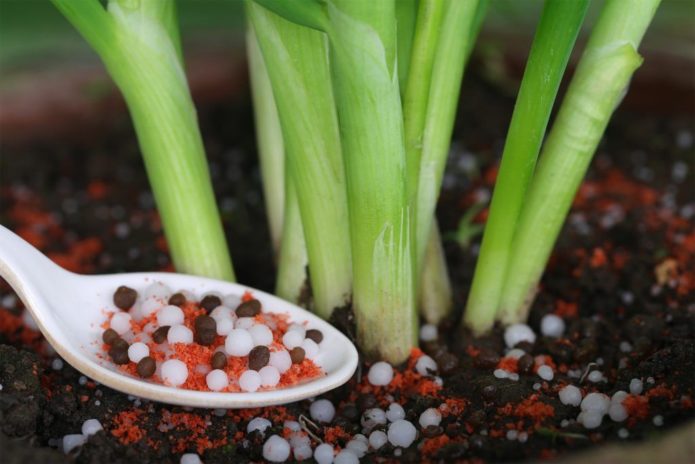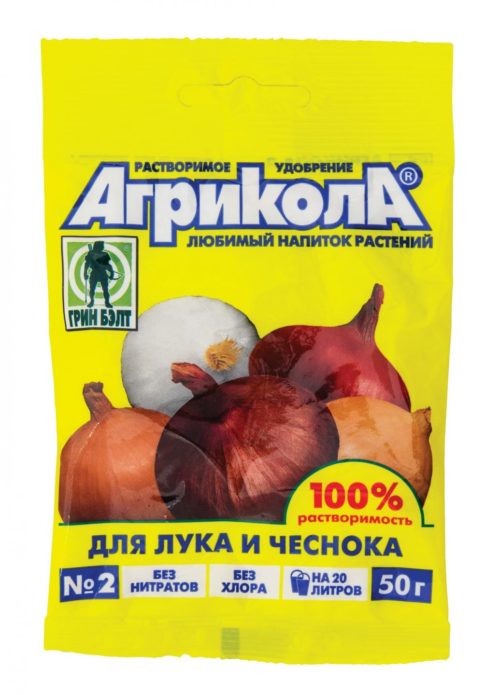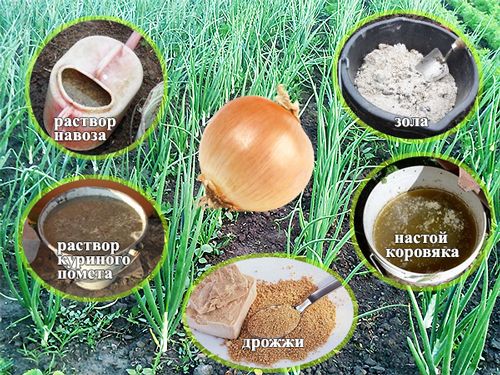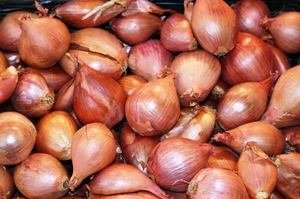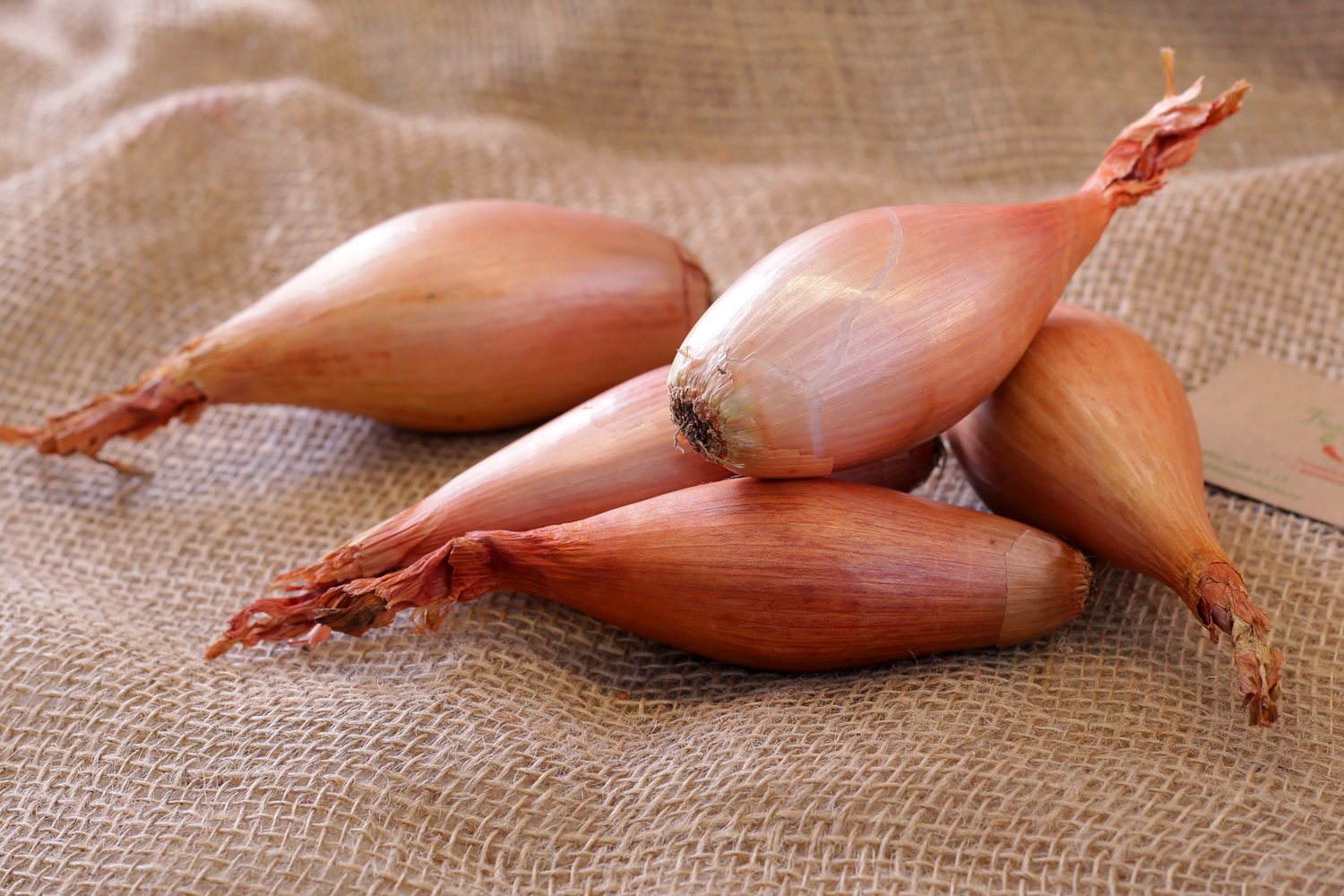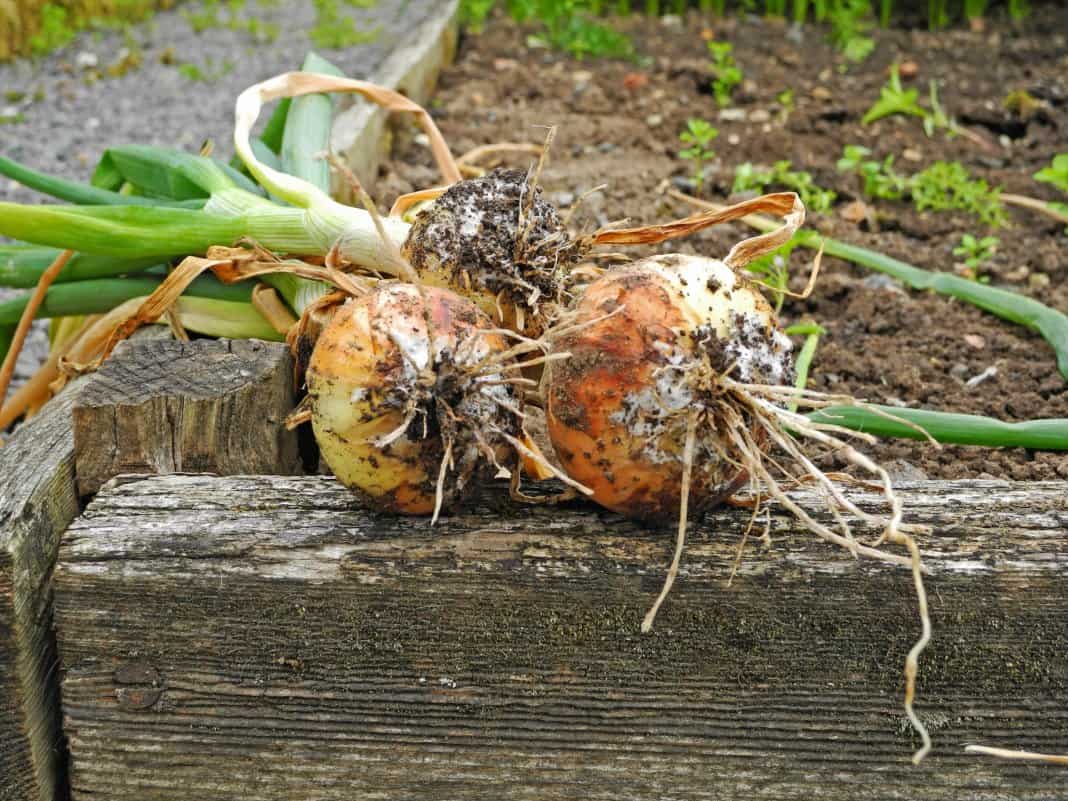It only seems at first that growing onions is a simple matter that does not require special knowledge: stick the onion into the ground and water, that's all. But in practice, it turns out that various feedings are required, the choice of which depends on the purpose of growing onions - to get green feathers or large and juicy turnips. For those who decided to plant onions in their personal plot, advice and recipes for feeding, tested in practice, will come in handy.
Content
The choice of planting material
For growing onions, loamy soils with a slightly alkaline or neutral reaction are preferred. Acidic soils are also suitable for growing bulbous plants, but the yield will not be high. That is why great importance is attached to soil preparation, illumination of the planting site and the choice of planting material.
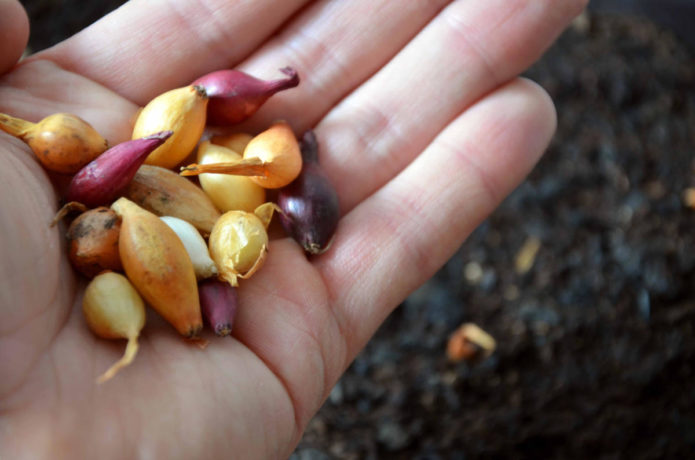
To avoid the appearance of arrows, the day before planting the seedlings need to be warmed up, for example, near the battery
If a set will be used for growing onions, it is recommended to choose an arbaazheka of the first group with a bulb diameter of 8 mm to 1.5 cm, and the second group, in which the bulbs are slightly larger - their diameter is 1.5–2.2 cm.
Arbazheyka is called an onion set weighing 2–5 g, which is obtained in the first year after sowing nigella - small black onion seeds.
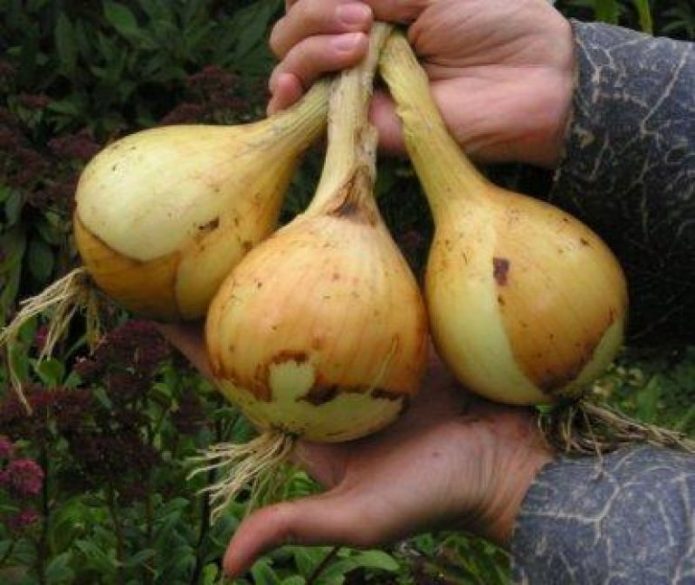
Sweet onions of the Exibichen variety can reach 900 g and do not irritate the mucous membranes of the eyes when sliced
When purchasing seeds for planting, you should pay attention to their expiration date: if the seeds are stale, there is a high probability that they will not sprout. It is also necessary to choose the right onion variety suitable for growing in the local climate. If you do not follow this rule and plant a variety adapted for the northern regions in the southern region, then the plant will constantly increase its leaf mass, and the size of the bulbs will remain underdeveloped. When planting an onion variety, zoned for the north of the country, the formation of bulbs will occur faster, and the growing season will be shortened, which ultimately will also lead to a halt in their growth.
Effect of plant spacing on bulb size
The distance between the plants also affects the size of the bulb. To obtain a large underground part, the planting material must be placed at a distance of at least 10 cm from each other, and the row spacing must be at least 25 cm. If these conditions are met, as well as with weekly loosening, weeding the soil and ensuring regular watering with moistening of the soil to a depth of 30 cm (at least 1 time per week), the bulbs will develop faster and increase their weight.

To build up a large mass of bulbs between the planting material, a distance of at least 10 cm must be maintained
Unlike other garden crops, onions do not need hilling, as it inhibits the ripening of the bulbs.
Top dressing recommendations
In order for bulbous plants to give good growth, you need to take into account the rules of feeding.
- First, try not to use fresh manure. Many types of onions simply do not tolerate it and begin to hurt, as a result, yield decreases.
- Secondly, when using dressings, do not allow them to get on the greens of the onions.
- Thirdly, observe the dosage of organic fertilizers, otherwise the increased growth of the aerial part will begin, and the bulbs will remain small.
- Fourthly, after each feeding, you need to water the plantings and loosen the soil, so the fertilizers will be absorbed better and faster into the soil.
- Fifth, stop fertilizing and watering 3 weeks before harvesting, otherwise the onion will ripen for a long time and deteriorate faster in the future.
The optimal time of day for feeding is evening, and the ideal weather is dry and calm.
Fertilizers for onions in the spring per head
If yeast top dressing is used as a top dressing, then a large underground part will grow on the onion. For the preparation of such a fertilizer, it is allowed to use both dry and raw yeast, which must be dissolved only in warm water.
- First you need to dissolve yeast: 10 g of granulated in 10 liters of water, or 100 g raw in 5 liters.
- Add 2 tbsp to the resulting solution. crushed and sieved ash, as well as 5 tbsp. l. granulated sugar.
- Leave the fertilizer for 1 hour to infuse.
- Use top dressing for watering at the root of the plant.
Thanks to yeast feeding, the soil is saturated with nitrogen and oxygen, and the work of yeast fungi improves the structure of the soil by displacing pathogenic flora. The effect of yeast feeding is especially noticeable on soil that is poor in humus and on depleted soil.
Top dressing for onions in June
In June, onions need fertilizers containing potassium and phosphorus. A lack of potassium manifests itself in the form of yellowed leaves, and with a deficiency of phosphorus, the tops of the bulbs begin to dry. When using such dressings, bulbous turnips are formed, their ripening is accelerated and the quality improves - they increase in size and become denser, due to which they are better stored.
Recipes for potassium-phosphorus fertilizers, which are enough for feeding 2 sq. m onion plantings:
- Nitrophoska solution, which will require 2 tbsp. l. top dressing for 10 liters of water.
- 1 tbsp. l of ammonium nitrate and salt dissolve in 10 l of water and add 10 g of 1% iodine.
- Herbal tincture - tamp a bucket of water by 30% with green weeds or nettles, pour 3 liters of water, dissolve 1 tbsp. l. yeast and leave to infuse for 3 days. Dilute the resulting concentrate with 9 liters of water.
To accelerate the growth of onions, nitrogen-containing fertilizers are also applied to the soil. You can use ammonia as a fertilizer: for 1 bucket of water, with a volume of 10 liters, only 3 tbsp. l. ammonia. For 1 sq. m of onion plantings is enough 1–2 liters of the resulting solution.
A good effect is observed when using organic fertilizers: in 10 liters of water you need to dilute 1 tbsp. l. urea and add 1 tbsp. mullein or chicken droppings. It is even easier to prepare another organic top dressing - dissolve 1 tbsp. manure in 10 liters of water. For 1 sq. m of the area where onions are grown, you will need 3 liters of fertilizer.
When applying fertilizers, it is important to observe the dosage: if it is exceeded, the growth of the green mass will increase, and the onion head will remain underdeveloped. And the lack of nitrogen in the soil can be determined visually - onion feathers will be underdeveloped and pale.
Fertilizers for onions
To get an excellent harvest of onions, you will need to spend at least three additional dressings during the growing season.
- The first feeding is carried out 12 days after planting. As a rule, this happens after the feather reaches a length of 10-15 cm. In 10 liters of water, you need to dilute 2 tbsp. l. complex feeding "Vegeta" or "Ideal", and add 1 tbsp. l. urea.This amount is enough for landings occupying 5 square meters. m. of land. Another top dressing recipe that is easy to make with your own hands: in 1 ten-liter bucket of water, you need to dissolve 20 g of potassium chloride, 40 g of superphosphate and 30 g of ammonium nitrate.
- The second - after 26 days have passed after planting the bulbs in open ground. For 1 sq. m of beds occupied by onions, you will need 4-5 liters of fertilizer for onions or garlic. Agricola No. 2, which is also suitable for the second feeding, has earned good recommendations among gardeners.
- The third feeding should be carried out after the formation of bulbs with a diameter of about 4 cm. In this case, you can apply a complex mineral fertilizer, for example, "Effecton-O". For 10 liters of water, you will need 2 tbsp. l. "Effekton-O" and 1 tbsp. l. superphosphate. Instead of a complex mineral fertilizer, you can prepare another nutrient solution: dissolve 30 g of potassium salt and 60 g of superphosphate in 10 liters of water. The resulting solution is enough for 2 sq. m landings.
Immediately before top dressing, the ground must be moistened, and then loosened the row spacing with a flat cutter... After loosening, the top dressing is better absorbed into the soil and will not spread. It is more convenient to spill liquid fertilizers into the aisles using a watering can.
When applying fertilizers, it is necessary to take into account the weather conditions: if the weather is rainy, then superphosphate with potassium salt is applied without being dissolved in water. Dry fertilizers should be applied to the soil to a depth of 6–9 cm, at a distance of 8 cm from the bulbs themselves.
Folk remedies for better bulb growth
Adherents of organic fertilizers can use slurry: for 1 bucket with a volume of 10 liters, 1 tbsp. manure. This dressing must be applied during the first dressing of bulbous plantations.
For the second top dressing, which directly affects the size of the bulbs, you can use herbal slurry: weeds growing in the summer cottage will benefit - they need to be filled with water, and oppression should be placed on top, for example, stones or bricks. After three days, the nutrient liquid is ready for use.
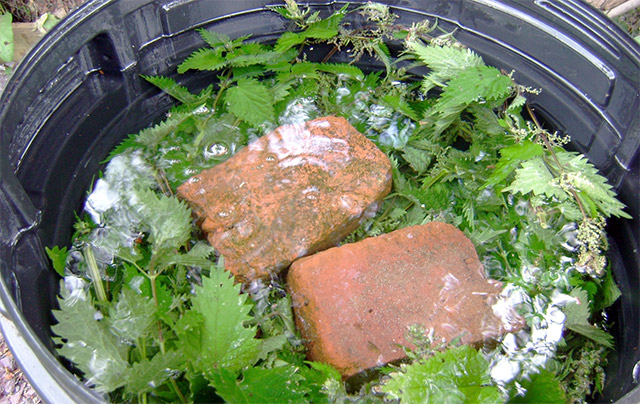
Herbal slurry is an effective remedy for the growth of bulbs, which is prepared from weeds growing in a summer cottage
As a third top dressing, ordinary ash is useful: 250 g of the substance must be poured with 10 liters of boiling water, and left to infuse for four days.
Reviews of gardeners
And to get a large bulb, you need nothing at all: plant the seedlings or seedlings in a well-prepared bed in time, do not thicken the planting, water and feed well in the first half of the growing season, when the feather grows, and do not cut off this very feather on the greens. And, the most difficult thing is to provide dry and hot weather in the second half of the growing season, when the bulb itself is growing. After that, there will be a trifle - to dig it up in time, before the rains, so that the roots do not start growing again. If some of this does not work out, the harvest will not be very good.
For feeding onions (any - I had onions from seedlings, Exhibitive from seedlings and leeks - from seedlings), as well as all bulbous flowers at the same time, for several years I have been using the mineral fertilizer "Onion-Garlic", I don't remember which company. One package (1 kg) is enough for planting in the fall and another one for the spring (planting and feeding). I trust the fertilizer manufacturers and their recommendations on the packaging in this matter.But our land has long been cultivated - it is 18 years for the garden.
Better feed the onion with ash, then the head will begin to tie. And do not bend the leaves. Let him lie down himself when he is ready for it. Put the leaves - the nutrients from the leaves will be more difficult to get into the bulb, and a good head will not work.
Video: the first feeding of onions with chicken manure infusion
To grow large onions, you need to carefully choose the planting material and be sure to feed the soil. If this is not done, the roots of the plant, which lie close to the upper fertile layer, will quickly deplete it. Therefore, onion care is an important part of growing it.
